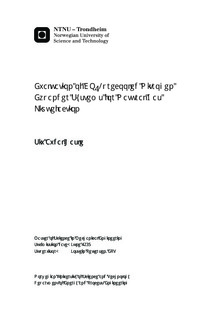| dc.contributor.advisor | Pettersen, Jostein | nb_NO |
| dc.contributor.author | Hasle, Siv Avdal | nb_NO |
| dc.date.accessioned | 2014-12-19T11:50:45Z | |
| dc.date.available | 2014-12-19T11:50:45Z | |
| dc.date.created | 2013-09-16 | nb_NO |
| dc.date.issued | 2013 | nb_NO |
| dc.identifier | 648645 | nb_NO |
| dc.identifier | ntnudaim:9996 | nb_NO |
| dc.identifier.uri | http://hdl.handle.net/11250/235148 | |
| dc.description.abstract | This Master thesis is a continuation of a project thesis written fall 2012 ?Evaluation of Liquefaction systems for Floating LNG?. Two processes for liquefaction of natural gas for a floating unit was compared and evaluated. The main basis for comparison came from simulations conducted in the simulation program Aspen HYSYS. These two processes were a dual mixed refrigerant process, DMR, from Air Products and Chemicals and a turbo-expander process from TOTAL. (Ref) The specific power consumptions for the processes were 284 kWh/ton LNG for the DMR process and 395.8 kWh/ton LNG for TOTALs turbo-expander process. Two additional liquefaction processes were simulated and studied in this Master thesis; a turbo-expander process from APCI and a turbo-expander from US patent 5,768,912. (Ref) The simulations gave a specific power consumption of 405.7 kWh/ton LNG for APCIs turbo-expander process and 422.5 kWh/ton LNG for the US patent model. These models were compared with the mixed refrigerant process from APCI and TOTALs turbo-expander process in terms of power consumption, volume flow rates of refrigerant and heat exchanger properties. The expander processes from TOTAL and APCI were dual expanders while the process from US patent 5,768,912 had three turbo-expanders. All expander processes were simulated with a CO2 precooling system. The liquefaction units had a production capacity of 3.5 Mtpa of LNG. The equipment in the DMR process was assumed large enough to handle the production capacity while the turbo-expander processes had to be divided in several production trains. The limitations for the expander process were a maximum compander capacity of 15 MW. TOTALs and APCIs turbo-expander had expander powers of respectively 49 and 55 MW for the largest expander in the processes and were divided into four trains. The turbo-expander from US patent was suggested with two production trains with a released power of 29 MW for the largest expander. A common CO2 system served the parallel trains for the turbo-expander processes.Process parameters of feed gas composition and pressure, water cooling temperature and split temperatures in the processes were some of the parameters included in a sensitivity analysis of the processes. A richer feed composition and a higher feed gas pressure gave reductions in power consumptions due to higher condensing temperature of the natural gas. Alternative systems for the precooling units with several evaporation stages of the CO2 were also studied and compared with the initial precooling system of one evaporation stage. A CO2 system with three evaporation stages gave reductions in specific power consumption of 0.6%, 2.1% and 4.7% for the expander processes from TOTAL, APCI and US patent respectively. The liquefaction processes were suggested with electric drive of the compressors. LM 6000 gas turbines were used for drivers of the processes. | nb_NO |
| dc.language | eng | nb_NO |
| dc.publisher | Institutt for energi- og prosessteknikk | nb_NO |
| dc.title | Evaluation of CO2-precooled Nitrogen Expander Systems for Natural Gas Liquefaction | nb_NO |
| dc.type | Master thesis | nb_NO |
| dc.source.pagenumber | 110 | nb_NO |
| dc.contributor.department | Norges teknisk-naturvitenskapelige universitet, Fakultet for ingeniørvitenskap og teknologi, Institutt for energi- og prosessteknikk | nb_NO |

